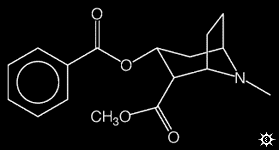





|
|
Relatives to the Caffeine Plant
Caffeine is one of many alkaloids produced by various plants for biochemical defence and other functions. Several stimulating alkaloids have been consumed as a beverage or food, but none have achieved the universal approval bestowed upon caffeine. In this page we take a quick glimpse at some of these alkaloids and their parent plants...
The coca plant (Erythroxylon coca) is a shrub native to the Andes Mountains. It produces the notorious alkaloid cocaine, which the natives of the region consume by mixing the leaves with powdered lime and chewing the resulting mixture. Unlike smoking or injecting the extracted compound, the habit of chewing the leaves shows few signs of being detrimental to the population or the structure of the society in which they live. Scientists are still unsure as to why this is.

The cocaine molecule
The ephedra plant (genus Ephedra, several species) is a native to arid regions throughout the world. Several of the species produce the alkaloid ephedrine, common in Western society for the treatment of asthma. The Chinese have used the stems to make tea, and health food stores currently stock many herbal stimulants containing the compound. Synthetic ephedrine and the closely related pseudonorephedrine are included in over-the-counter allergy and cold medicines.
Betel (two unrelated plants, the areca plant, Areca catechu, and the betel pepper, Piper betle, both go by this name) is used as a stimulant throughout southern Asia. The chewing of the "betel nut" (the seed of the araca plant) wrapped in the leaf of the betal pepper is a habit for approximately ten percent of the total world population¹. The nut contains arecoline, used in the veterinary sciences as a worming agent.
Yohimbe (the bark of Corynanthe yohimbe)
has been used as an aphrodisiac for centuries in central Africa. The active
ingredient is said to be the alkaloid yohimbine, although expert opinion
is divided over this issue, with some claiming that the compound has little
or no effect unless consumed in toxic doses. Nevertheless, alternative
medicines across the world, and especially in the US, have increasingly
incorporated yohimbine into products aimed at curing impotence.
¹ Encyclopaedia Britannica,
"Betel", vol.2, p.172 (1990)
Why do plants contain caffeine? It gives humans a buzz... but why did plants evolve the ability to produce caffeine in the first place?
Where do we find caffeine?
The major natural sources of caffeine...
Image used without permission from
the following source:
Cocaine structure
http://www.erowid.org/chemicals/cocaine/cocaine.shtml
|
|